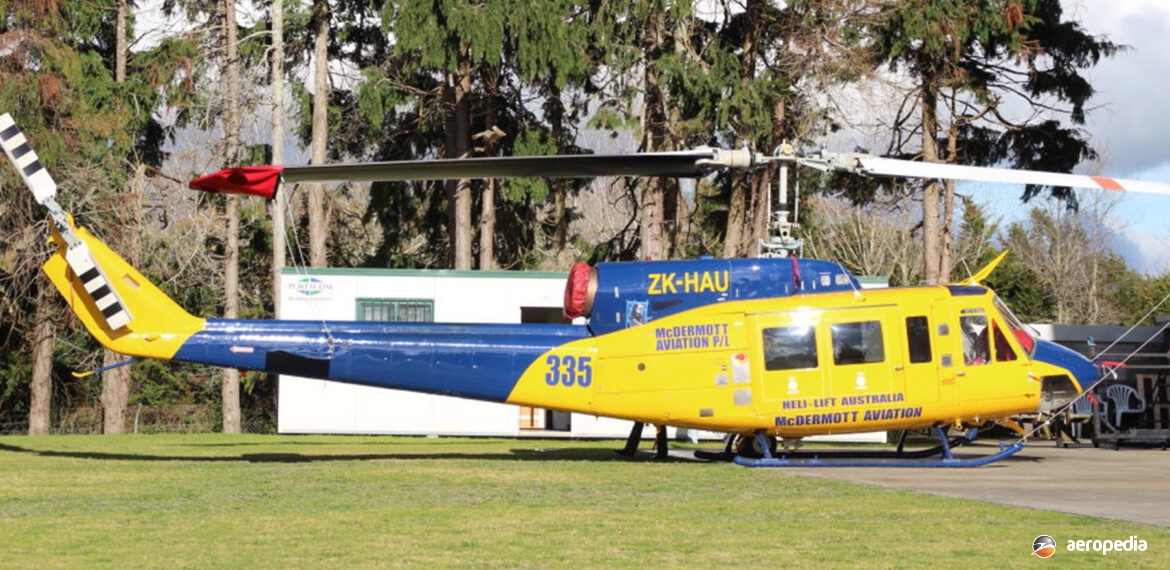Photograph:
Bell 214ST ZK-HAU (c/n 28036) at Ardmore, New Zealand (NZCIVAIR)
Country of origin:
United States of America
Description:
General purpose utility helicopter
Power Plant:
Two 1,212 kw (1,625 shp) General Electric CT7-2A turboshafts limited to a combined output of 1,678 kw (2,250 shp)
Specifications:
- Rotor diameter: 15.85 m (52 ft)
- Overall length: 18.95 m (62 ft 2 in)
- Fuselage length: 15.03 m (49 ft 4 in)
- Height: 4.85 m (15 ft 11 in)
- Main rotor disc area: 197.4 m² (2,124 sq ft)
- Max cruising speed at 1,219 m (4,000 ft): 260 km/h (162 mph)
- Max cruising speed at sea level: 264 km/h (164 mph)
- Economical cruising speed: 249 km/h (155 mph)
- Max initial rate of climb: 543 m/min (1,780 ft/min)
- Hovering ceiling out of ground effect: 1,830 m (6,000 ft)
- Single-engine ceiling: 2,440 m (8,000 ft)
- Range with 20 mins reserve: 740 km (460 miles)
- Empty weight: 4,300 kg (9,481 lb)
- Loaded weight: 7,938 kg (17,500 lb)
History:
The Bell Model 214ST (ST for super transport) was a development of the Model 214B (known as the Big Lifter) and replaced that model on the production line in early 1981, deliveries of Model 214STs to customers beginning in early 1982. A development/test-bed aircraft for the 214ST series flew for the first time in March 1977, three distinct prototypes subsequently being built for the certification programme, one in military configuration, and two in civil configuration. These machines commenced this programme in August 1979, and work commenced on an initial series of 100 machines in 1981.
The Bell 214ST development programme was undertaken by Bell Helicopter in collaboration with the Government of Iran, the Company having a contract at that time to establish a helicopter production plant in Iran which was expected to assemble and service Model 214STs to be purchased for the Iranian Imperial Army. This order was originally for 400 Model 214As but was later reduced to 50 examples of the single-engined 214A, and 350 examples of the twin-engined 214ST.
Variants were produced to meet customer requirements, one variant with a wheeled undercarriage in place of the skids being certificated in March 1983. Various alternative layouts as to the number of passengers which could be carried were available, and examples were supplied to the air forces of Venezuela and Peru, and the Thai Army. Examples were also supplied to China.
Maximum continuous output of the two engines, which were known as the T700/T1C in the military version, was 2,424 kw (3,250 shp) but the transmission was rated to a maximum of 1,678 kw (2,250 shp), which the engines could maintain up to a height of 1,830 m (6,000 ft) at temperatures up to 32 deg C (95 deg F). In the offshore support role it could carry up to 16 passengers and a crew of two, whereas as a high-density military transport it could carry 17 troops. A tactical combat version was able to carry a crew of four and a 12 man squad. In the ambulance role it could carry six stretchers and two cabin attendants.
Only a small number of examples have been seen in this region. The first VH-LAO (c/n 28116 – ex N3176B) commenced service with Lloyds Offshore Helicopters of Norwood, SA in January 1986 but was destroyed in a crash into the Timor Sea on its way to Troughton Island, WA to the drilling vessel ‘Energy Searcher‘ on 28 March 1989.
VH-LHT (c/n 28109 – ex G-BKFN) was registered on 17 December 1991 but became VH-BEE a week later, later again being exported as G-BKFN and subsequently carrying the registrations LZ-CAW, G-BKFN, N727HT and C-GDYZ.
VH-LHT² (c/n 28117 – ex JA-9609) which was registered on 17 December 1991 was also later exported, becoming N214EV and N393AL.
VH-LAT (c/n 28131 – ex N3185W) of Lloyd Helicopters was registered on 10 August 1987 but ditched in the sea on 7 April 1995 440 km (273 miles) WNW of Darwin, NT near the ‘Atwood Eagle’ rig after the tail rotor drive failed and was lost.
The Model 214B Big Lifter was an up-graded variant with more powerful 2,186 kw (1,930 shp) Lycoming turboshafts and one of these (P2-OSW) was imported by Heli Services / Helikopter Services for operations in the oil fields of Papua New Guinea.
Model 214ST VH-LHQ (c/n 28101 – ex N8045T) was registered on 27 July 1990, was later exported, becoming G-MNDU, N214BE, C-GSTQ and N3912B.
VH-LUU, also a 214ST (c/n 28102 – ex N5748M), which was later exported as ZK-HWK² (c/n 28102), arrived in New Zealand in August 1990 for logging work, eventually becoming N5748M and N3912U.
Examples of the Model 214 series have operated in this region for fire-bombing and heavy-lift operations operating with US registrations.

